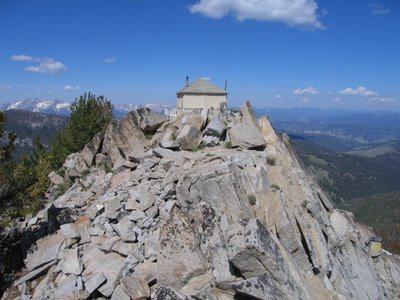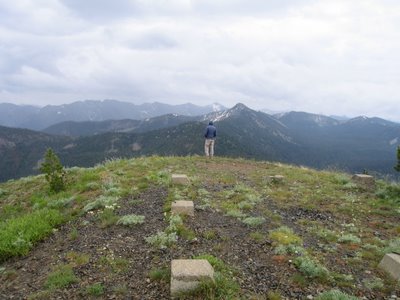
The day started out spectacular. After the clouds and rain of the previous day, the morning was clear and bright. Our goal was Trapper Peak. We saw this one from the vantage of
Medicine Point Lookout – it was a high peak, and according to the map there was an established trail to the summit. It was a seven mile steep dirt road from the highway, and we were hiking by 9 am.
John realized he forgot his wind jacket and pants after the first 10 minutes on the trail. Dilemma – risk going to the peak without or go back and get them? The weather could change quickly, and it was bound to be breezy on the peak, so he decided to go back and get them. Let me point out the trail to the peak was steep – about 3,700 feet elevation gain in five miles – and the path from the trailhead parking lot was straight up. But John, frustrated with his forgetfulness, ran down the trail to retrieve his gear, and hustled back up. By the time he got back to where I was waiting, perched on a rock in the sun, he was sweating and breathing heavily.
We continued on. The last portion was cross-country over boulders with only a few cairns to mark the route. We did not expect to see anyone – it was the middle of the week, and we have become accustomed to the solitary remoteness of our hikes. To our surprise we met a man on his way down, a biology teacher from Helena, looking for the elusive
Parry's Primrose, which only grows above 10,000 feet. Trapper Peak was the northernmost occurrence of this flower. He spoke with a Swedish lilt, and described to us the purple flower so we also could search it out.
We made it to the summit for lunch and the customary ritual of taking pictures of the entire 360 degree view. The view was not what we expected – our previous day’s hike to the south was lower in elevation, deep in the forest, and our views were slightly obscured by the inclement weather. From Trapper Peak, however, we saw the Bitterroot Mountains in their full glory – massive granitic rocks, steep cirques polished by glaciers. The range has a definite grain, with deep, straight canyons running east-west, stacked in series from south to north. Another couple, locals from Missoula, reached the summit as we were preparing to head down. In addition to giving us hints on camping spots and health food stores, they told us Trapper Peak was also the highest peak in the range at 10,157 feet. An accidental peak of significance for us! The picture of the day is us at the summit celebrating this fact.
So, John’s penance for forgetting his wind gear was sore muscles from running down a steep trail. My penance will be to write 100 times “I will not forget my boots at the trailhead”. I did not notice this fact until the day after our Trapper Peak hike that my boots were not in the car. I did not remember putting them in after changing into sandals at the end of the hike, so the best guess was they were still at the trailhead. So we packed up camp early and made a detour up and back on that dusty, rough dirt road to retrieve them. Fortunately, nobody with a women’s size 10 foot noticed them, and the rodents stayed clear of the odorous wonders. When we pulled up to the spot where we parked the day before, there they were – looking perky like they were ready for another hike.
So I am going to get started…
I will not forget my boots at the trailhead…I will not forget my boots at the trailhead…I will not forget my boots at the trailhead…I will not forget my boots at the trailhead… I will not forget my boots at the trailhead…I will not forget…
Posted using free wi-fi from the public library in Missoula, Montana.










